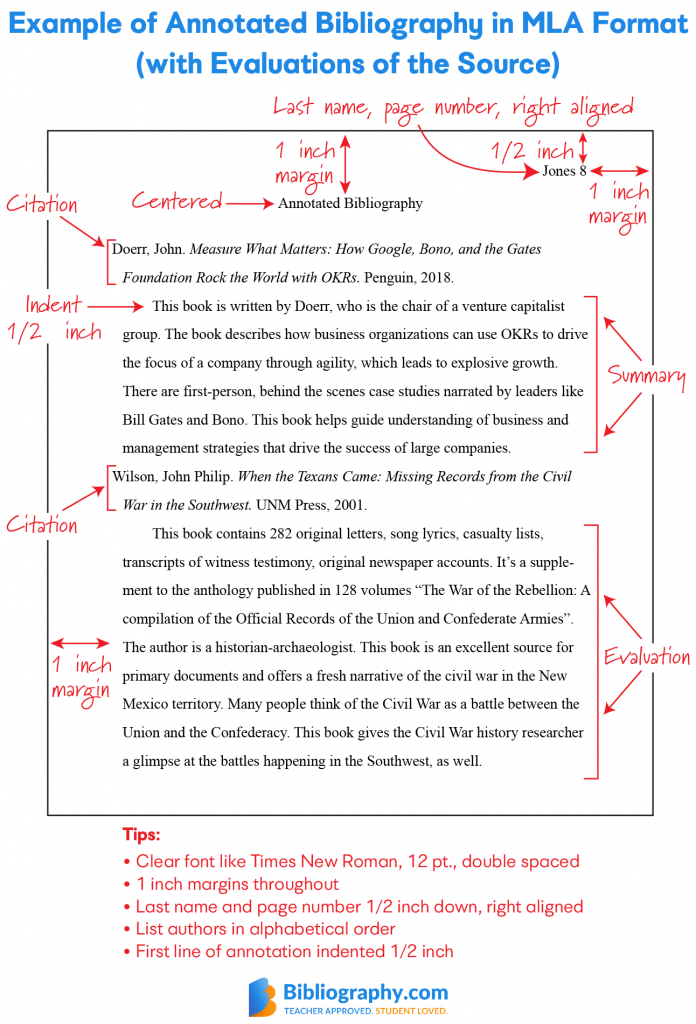Is your professor asking you to write an MLA annotated bibliography? Are you clueless? You’ve come to the right place. The world of bibliographies can be a tricky web to weave, especially when talking about annotated bibliographies. Take a deep breath and get ready. You’re going to learn everything you need to know to make an annotated bibliography in MLA 8 style.

MLA Annotated Bibliography Overview
MLA typically uses a works cited. But there might come a time when a professor asks you for an MLA annotated bibliography, too. An annotated bibliography takes your references to the next level. In addition to providing a citation, it gives you more information through an annotation: a fancy word for further explanation.
The Use and Difference of an MLA Annotated Bibliography
A standard bibliography provides necessary information about your source. You have the author, title, and publication information. But, sometimes that’s not enough. An annotated bibliography can provide a more in-depth study or evaluation.
In the process of creating your paper, you have become a topic expert. Show the world your expertise. Demonstrate why the source was perfect for your audience, and for the central theme of the article or book. It also allows you to show how this work compares to others you’ve discussed.
MLA Annotated Bibliography Example
Now that you know what an MLA annotated bibliography is, check out what it looks like through an example of an MLA annotated bibliography.

How Do You Write an Annotated Bibliography in MLA Format?
Before looking at the steps to creating an MLA annotated bibliography, there are a few things to remember about formatting. For example, do you double-space an MLA annotated bibliography? Yes, you do. Explore other fun formatting facts for creating your MLA annotated bibliography.
- Annotated bibliographies don’t have specific guidelines in the 8th edition MLA handbook for making quotes. Therefore, if you need to include quotes, keep them short.
- Use hanging indents for citations. The first line starts on the left margin, but indent consecutive lines five spaces.
- Indent the beginning of the annotation.
- The annotation is typically between 100 and 300 words.
- Title the page “Annotated Bibliography” or “Annotated List of Works Cited.”
- Double-space your annotated bibliography.
Now that you know how to format MLA citations, it is time to begin writing.
Step 1: Create Your Citation in MLA
Citations vary depending on what you are citing. For example, the format for citing a book is different than a magazine. MLA breaks down the core elements of your citation to author, title, the title of container, contributors, version, number, publisher, publication date, and location. For a website or digital file, include a URL as well. Check out an example:
Annotated Bibliography
Austen, J. Pride and Prejudice. Oxford, Oxford University Press, 2004.
Step 2: Create the MLA Annotations
Creating the annotation is the pivotal part. This is an annotated bibliography, after all. The first thing to think about is whether this is a summary annotation or evaluative annotation. Per the names, the summary annotation provides a summary while an evaluative annotation evaluates the work. Examine each one in more depth:

- Summary Annotation: This type summarizes the source for the readers, letting them know the central theme of the book, plus information about the author and the target audience of the book.
- Evaluative Annotation: This type of annotation goes into more depth about the author, including any expertise and bias they have. It might compare the work to other works and delve into why it was used for the topic, along with the strengths and weaknesses you found.
Difference in MLA
MLA was designed for humanities writers. These are the people that write about literature, philosophy, and cultural science, to name a few. In these areas, you’ll see writers comparing one work to another. Therefore, this type of writing is more focused on the writer of sources and where to find them, which is where citations focus.
Annotation Master
While an MLA annotated bibliography might look terrifying, remember you are an expert. You’ve done the research and have all the skills to prove to your audience why this source was perfect for your paper. You can also get more information about how to create your annotations for any style annotated bibliography by looking at how to create an annotated bibliography with examples.
FAQ MLA Annotated Bibliography Examples and Writing Guide
How do you write an annotated bibliography?
To write an annotated bibliography, you include a title, citation, and annotation. The title and citation might vary based on the writing style, (i.e., MLA, APA, Chicago, etc.); however, the annotation is the same for all styles. The annotation can be a summary or evaluative annotation.
Are MLA annotated bibliographies double spaced?
Yes, an annotated bibliography in MLA is double spaced. The annotative bibliography in MLA should follow all the formatting guidelines for the rest of the paper, including centering the title, adding a page number, and double spacing.
What are the two types of annotated bibliography?
The two types of annotated bibliography you commonly come across in MLA format are the summary and the evaluation annotative bibliographies. A summary annotated bibliography provides a summary of the sources. An evaluative annotated bibliography goes into more depth by evaluating the authors and providing a critic of the sources.
How do you write an annotation?
To write an annotation, you need an in-depth understanding of the work. You then must decide if you are going to write a summary of the work through a summary annotation or evaluate the work through an evaluation annotation. You'll then compose your annotation which is between 100-300 words.
Does an annotated bibliography need a conclusion?
No, an annotated bibliography does not need a conclusion. Your annotations simply provide a summary and critic of your sources. Since this is just a short paragraph, you do not need to include a conclusion in your annotations.
